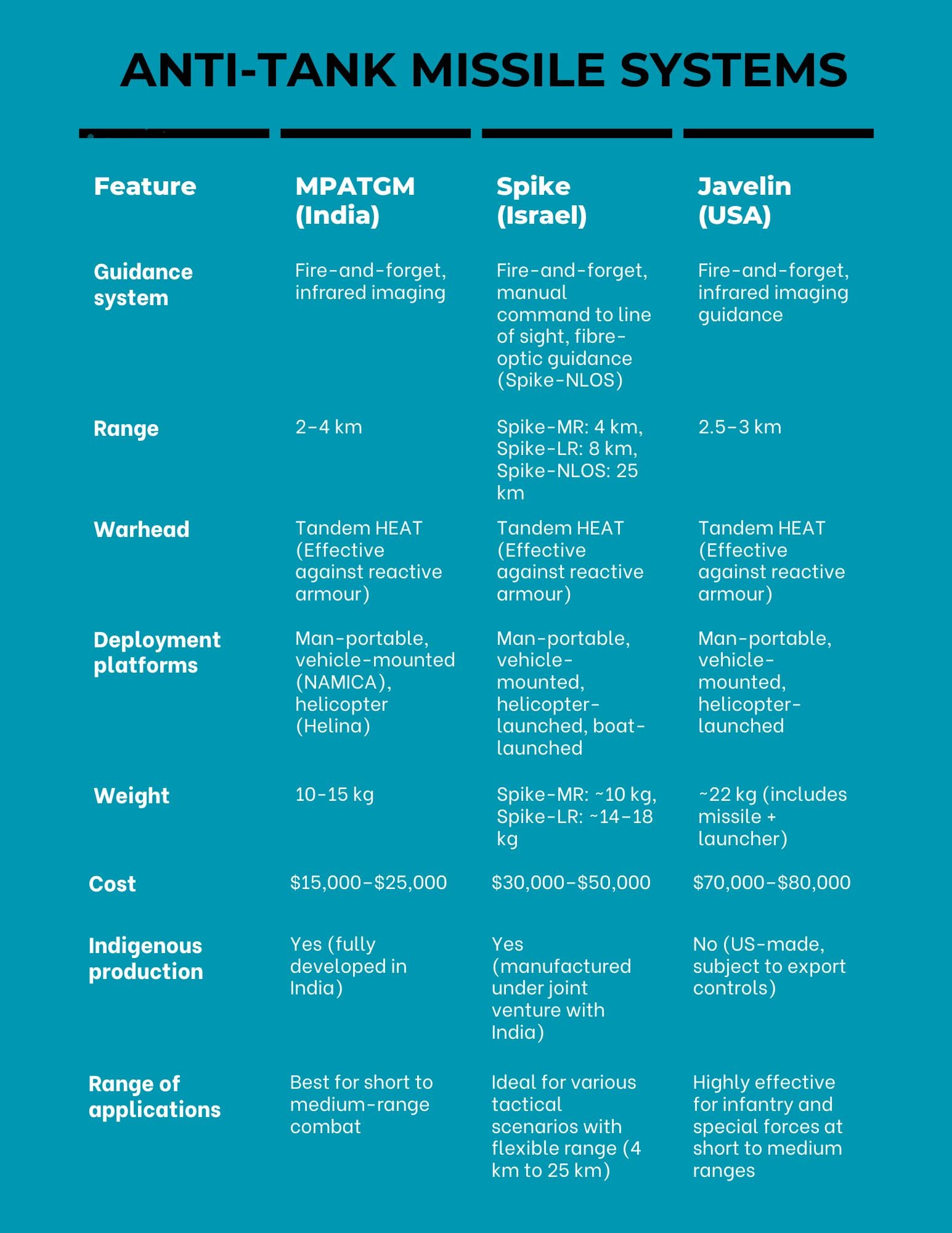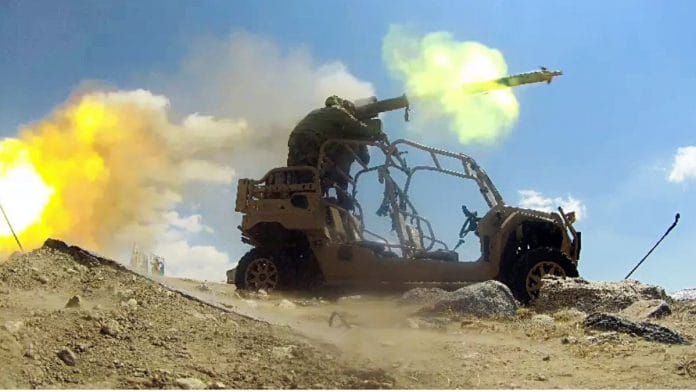India’s quest for a modern and versatile Anti-Tank Guided Missile has been a critical component of its defence strategy. The induction of modern, third-generation ATGMs is vital for strengthening India’s military capabilities, especially considering its regional security concerns and the need to counter modern armoured threats.
Over the years, India has worked on developing indigenous ATGMs to enhance its defence capabilities, reduce dependency on foreign arms suppliers, and increase the operational effectiveness of its armed forces.
However, a large and critical gap remains between current capabilities and proposed indigenous alternatives that need to be addressed — the most critical being the lack of a modern man-portable (man-pack) version.
Building India’s Indigenous MPATGM
The MPATGM (Man-Portable Anti-Tank Guided Missile) is a crucial part of India’s effort to develop indigenous anti-tank missile systems to enhance the Army’s capabilities against armoured threats. The MPATGM project, sanctioned in 2010, is being developed by the Defence Research and Development Organisation (DRDO) to provide infantry units with a lightweight, portable missile system that can be used effectively against modern tanks and armoured vehicles.
As part of the MPATGM’s development, India has focused on creating the necessary manufacturing capabilities within the country. Bharat Dynamics Limited (BDL), an Indian defence public sector undertaking, is expected to handle the missile’s production once development reaches full maturity. The MPATGM is expected to be integrated into the Army’s infantry and special forces units, providing them with a powerful tool for anti-tank warfare in various combat environments, including urban warfare, and conventional battles.
In 2023, the DRDO conducted a series of field trials for the MPATGM across different ranges and launch conditions. These tests were reportedly successful, with the missile hitting its targets with high precision and demonstrating its effectiveness in test conditions. It will now need to be offered to the Army for user trials and validation. According to DRDO officials, the MPATGM is expected to be inducted into service in the next few years. The system will only be cleared for large-scale production once final qualification tests are completed.
ALso read: Ukraine-Russia shows us the future of war with high-end ATGMs, drones. India has to step up
Spike deal spiked and emergency buys
It has taken over a decade to reach the present status, during which critical operational voids had to be plugged. In 2018, a proposal to buy the Israeli Spike ATGM — comprising 8,000 missiles and 300 launchers at an estimated cost of Rs 3200 crores ($500) million — was cancelled at the last moment, just days before a scheduled visit to India by Israeli Prime Minister Benjamin Netanyahu. Although there were reports of the deal being revived after talks between Prime Minister Narendra Modi and Netanyahu, nothing much came out of it, with the cancellation attributed to policy changes and bureaucratic concerns.
Between 2010 and 2020, India faced two major crises on its northern borders with China. The first was the Doklam crisis of 2017, when China attempted to build a road within the disputed territory with Bhutan. The tense, over two-month-long standoff was resolved when both sides agreed to revert to the status quo ante. In response, Emergency Powers (EP) for capital procurement were delegated to the three Service HQ. Under the EP provisions, the Army bought limited quantities of Spike ATGMs within the approved ceilings, as the indigenous MPATGM was nowhere on the horizon.
Fast forward to 2020, during the Galwan crisis, EP powers were once again delegated. Faced with similar capability gaps, the Army had to procure Spike ATGMs again, within the delegated ceiling of Rs 300 crore. Numerically, both procurements combined were only a fraction of the original requirement. Had the original deal gone through, the Army would not have had to resort to emergency procurements and would have been better prepared operationally.
US’ Javelin complicates ATGM hunt
While the search for a suitable third-generation ATGM continues, the quest has been further complicated by the US offer of the state-of-the-art Javelin ATGM.
Developed by Raytheon and Lockheed Martin, the Javelin is one of the most advanced third-generation ATGMs in the world. With its fire-and-forget capability, infrared guidance system, and top-attack profile, it is highly effective against modern armoured vehicles, including the latest tanks in service.
Given India’s strategic needs, particularly in countering evolving threats from Pakistan and China, the Javelin missile could be a viable option for enhancing India’s anti-tank warfare capabilities. However, whether it is a good option will depend on several factors, including cost, availability, technological alignment, and strategic goals. Like any new induction, it would also need to undergo trials and evaluation, which is a time-consuming process.

Also read: Army’s stock of anti-tank guided missiles & launchers is outdated & fast running out
Choosing India’s anti-tank future
Comparatively, the MPATGM is a cost-effective, indigenous solution that meets India’s tactical needs for short to medium-range engagements and suits infantry and special forces with a strong focus on self-reliance. However, its shorter range and current non-operational status could delay its induction and hinder its adoption as a primary anti-tank weapon in the short term.
The Spike family is a versatile system with multiple variants for different needs, including long-range capabilities (up to 25 km). With the baseline variant already in service with the Indian Army, it is an excellent option for longer-range engagements, though its higher cost and reliance on foreign technology (Israel) could limit large-scale deployment.
The Javelin, meanwhile, is a highly effective and proven system for infantry use with top-attack capabilities. It excels in short to medium-range engagements but suffers from high costs and geopolitical dependencies, particularly under the current US administration, which could limit its suitability for large-scale use.
Ultimately, each missile system has its strengths: the MPATGM offers an affordable, indigenous option; Spike provides multi-range flexibility; and Javelin delivers cutting-edge technology though at a high cost with uncertain export controls. The final choice will depend on India’s evolving operational needs and the constant balancing act between technological superiority and budgetary constraints.
General Manoj Mukund Naravane PVSM AVSM SM VSM is a retired Indian Army General who served as the 28th Chief of the Army Staff. Views are personal.
(Edited by Prashant)






